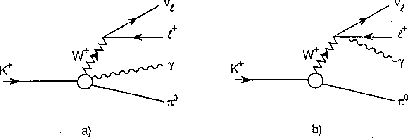 has the general structure
has the general structure
The matrix element for  has the general structure
has the general structure
The diagram of Fig. 4.1.a corresponding to the first part of
Eq. (4.1) includes Bremsstrahlung off the  .
The lepton Bremsstrahlung diagram of Fig. 4.1.b is represented
by the second part of Eq. (4.1).
The hadronic tensors
.
The lepton Bremsstrahlung diagram of Fig. 4.1.b is represented
by the second part of Eq. (4.1).
The hadronic tensors  are defined as
are defined as

 is the
is the  matrix element
matrix element

The tensors  and
and  satisfy the Ward identities
satisfy the Ward identities
leading in turn to
as is required by gauge invariance.
For  , one obtains the corresponding amplitudes and
hadronic tensors by making the replacements
, one obtains the corresponding amplitudes and
hadronic tensors by making the replacements

To make the infrared behaviour transparent,
it is convenient to separate the tensors  into two parts:
into two parts:
Due to Low's theorem, the amplitudes  are finite for
are finite for  . The axial amplitudes
. The axial amplitudes
 are automatically infrared finite.
The Ward identity (4.4) implies that the vector amplitudes
are automatically infrared finite.
The Ward identity (4.4) implies that the vector amplitudes
 are transverse:
are transverse:

For on-shell photons, Lorentz and parity invariance together with gauge invariance allow the general decomposition (dropping the superscripts +,0 and terms that vanish upon contraction with the photon polarization vector)
With the decomposition (4.7) we can write the matrix element
for  in (4.1) in a form analogous to Eq.
(1.2) for
in (4.1) in a form analogous to Eq.
(1.2) for  :
:
The four invariant vector amplitudes  and
the four axial amplitudes
and
the four axial amplitudes  are functions of three scalar
variables. A convenient choice for these variables is
are functions of three scalar
variables. A convenient choice for these variables is
where W is the invariant mass of the lepton pair. The amplitudes
 can be expressed in terms of the
can be expressed in terms of the  form factors
and depend only on the variable
form factors
and depend only on the variable

Figure 4.1: Diagrammatic representation of the  amplitude.
amplitude.
 .
For the full kinematics of
.
For the full kinematics of  two more variables are
needed, e.g.
two more variables are
needed, e.g.
The variable x is related to the angle  between the
photon and the charged lepton in the K rest frame:
between the
photon and the charged lepton in the K rest frame:

T invariance implies that the vector amplitudes  , the
axial amplitudes
, the
axial amplitudes  and the
and the  form factors
form factors
 are (separately) relatively real in the physical region.
We choose the standard
phase convention in which all amplitudes are real.
are (separately) relatively real in the physical region.
We choose the standard
phase convention in which all amplitudes are real.
For  (collinear lepton and photon), there is
a lepton mass singularity in (4.1) which is numerically
relevant for l = e.
The region of small
(collinear lepton and photon), there is
a lepton mass singularity in (4.1) which is numerically
relevant for l = e.
The region of small  is dominated by the
is dominated by the
 matrix elements. The new theoretical information of
matrix elements. The new theoretical information of
 decays resides in the tensor amplitudes
decays resides in the tensor amplitudes
 and
and  . The relative importance of these
contributions can be enhanced by cutting away the region of low
. The relative importance of these
contributions can be enhanced by cutting away the region of low
 . It may turn out to be of advantage to
reduce the statistics by applying more severe cuts than necessary from
a purely experimental point of view.
. It may turn out to be of advantage to
reduce the statistics by applying more severe cuts than necessary from
a purely experimental point of view.